My son is eight years old, the age at which curiosity, acquired knowledge, and a total fascination with disaster scenarios come together beautifully and lead to all kinds of thought-provoking (and sometimes horrifying) what-if questions. What if the house blew up just as we were about to step inside of it? What if a tornado ripped through town unexpectedly while summer camp was in session? What if we went to watch a baseball game at Yankee Stadium and an earthquake happened in the first inning?
That last one gave me pause. What if an earthquake did happen during a baseball game? What if you run a sports facility or a recreation complex or, for that matter, a gym, health club, or fitness center and you’re faced with a major emergency? How do you prepare yourself? How do you even begin to think of something as massive, and as potentially devastating, as an earthquake?
Kevin Bryant, a senior facility manager for the Gordon Faber Recreation Complex in Hillsboro, Oregon (which boasts a 3,700-seat baseball stadium, a 7,200-seat football/soccer stadium, and six softball fields) addressed such questions in a recent article for Sports Venue Safety, a supplement to Athletic Business. Bryant has encountered a number of extraordinary situations at his facility: a drunk and belligerent spectator, drug-use by a semi-professional sports team in the locker room, lights going out during a stormy, night-time, high-school football game. None of these are on the scale of an earthquake, but they got him thinking about the importance of being ready should a major emergency occur.
In order to frame out a coherent emergency plan, including an evacuation strategy, Bryant and his team—full-time and part-time staff—engaged in a months-long effort. Starting with the simple plan they already had (and you no doubt have at least a simple one of your own), they called upon the expertise of police and fire first-responders, city staff, and school district personnel. They researched actual emergencies that had happened at other facilities, used virtual reality software, and good, old-fashioned brainstorming to imagine potential situations. At the end of the process, they produced a carefully crafted, solidly tested, emergency and evacuation plan.
Bryant offers some useful advice. The first step, he says, was getting practical training for all full-time staff so that, at the very least, everyone knows how to administer basic first-aid and everyone has some AED and CPR training. Whether you run a sports facility or a gym or health club, you’ve probably prepared key staff members for simple emergencies in similar ways. But it’s worth asking yourself whether you’ve trained enough staff and whether new employees need training. Do you have a plan for yearly refresher sessions?
After training, Bryant and his team made a list of the exact types of emergencies they might encounter at their facility and then researched preferred ways of dealing with those emergencies. They looked into bomb threats, critical operations shutdowns, fires in and outside the stadium, extreme weather situations (including, yes, earthquakes), medical emergencies, and even nuclear fallout. They outlined, among other things, what the immediate reaction to each type of emergency would be, who would be responsible for what, and how the city and first-responders would be involved. The take-away here is that different kinds of disasters require different kinds of responses. At your facility, you must have a specific plan for each kind, and all the players must be clear on their roles.
Once you’ve got your written plan, you need to start another round of training—this time stepping through the actual plan as if an emergency had occurred. Bryant’s staff went through a fire drill. On a day when there was no event, they pulled the fire-alarm, role-played responses, and then discussed how it all went. The exercise revealed the importance of communication in the midst of chaos, noise, and stress, and showed Bryant that, while a written plan is crucial, realistic training is the only way to get all players on board with how to manage an actual situation.
Another great thing about eight-year-olds is that they’re convinced they can overcome any disaster scenario they might have to face; when my son explains how he’s going to deal with the tornado-at-summer-camp, or any other similar situation, he always describes his own deeds of daring and his phenomenal, heroic triumphs. I love his confidence and optimism, but I always try to remind him that he has a good chance of succeeding as long as he has a carefully thought-through plan.

Planning for Emergencies
« Blog | | | (0) Comments